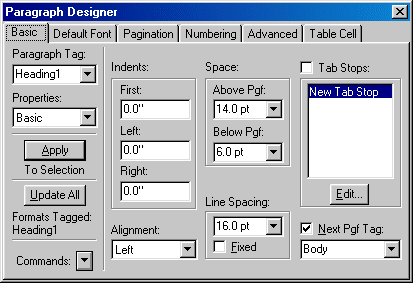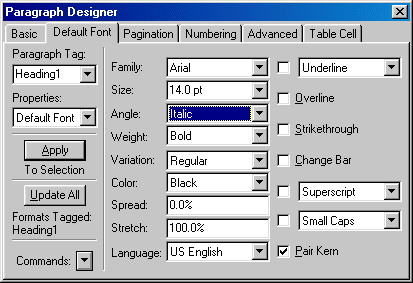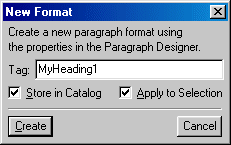FrameMaker 7.0 Tutorial: Paragraph & Character Tags
About Tags
If you are not familiar with using and creating styles or tags in a word-processing or desktop publishing application, read this section first.
A tag is a unique set of formatting characteristics. Textual elements like headers, footers, special notices, labels within illustrations, and figure titles are all examples of tags. A typical heading that uses Arial font, 24 point size, bold, 18 points of space above, and 9 points of space below is a tag. Plain, ordinary body text — the standard paragraph of a document — is a tag. The set of formatting characteristics that make up a bulleted or numbered list is another example of a tag.
In the Introduction and Basics tutorial, you learned about the two types of tags, paragraph and character tags, that FrameMaker uses to format text. Paragraph tags allow you to format a paragraph of text. Character tags allow you to format a character or characters within a paragraph without changing the entire paragraph. Take a look at any document, and count the different tags that you see.
Tags are valuable because:
- Tags save time. Instead of specifying Arial font, 24 point size, bold, 18 points of space above, and 9 points of space below every time you want to create that style of heading, you can simply select the tag name and apply it to the text you want.
- Tags provide consistency. If you work on large documents, work on a document over a long period of time, or work with other people on the same document, it is difficult to ensure that textual elements look the same throughout. Tags make it easy to maintain consistency.
If you design your document properly, you should not have to manually create textual elements. Of course, when you create a first draft, it’s hard to foresee all the tags that you may need. Instead of manually changing a number of paragraphs to be indented and to use a smaller type size, you can name the paragraph format as a tag and apply it to each paragraph.
In simple documents, such as letters and memos, you must press the Enter key twice to create a blank line between paragraphs. However, when you create a professionally-designed document, you never press Enter to create space between textual elements. You also never use the spacebar to create horizontal space, or even use tabs. All the formatting and alignment details are specified in the tags for that document.
Using FrameMaker Tags
FrameMaker offers unlimited tags and many templates that contain tags, as well as page layout specifications.
To explore the tags used in an existing template:
- Open FrameMaker.
- Select File > New > Document.
Tip: You can also use the keyboard shortcut Ctrl + N to open a new document. - In the New dialog box, click Explore Standard Templates.
- From the listed located in the left column, select a template to view.
- To view more templates, click Down.
- Under the Book heading, select Chapter.
- In the right side of the dialog box, click Show Sample.
- Within the document, place your cursor in various areas of the text.
The tag names appear in the Paragraph Format pull-down menu located on the FrameMaker toolbar.

- Open the Paragraph Catalog by clicking the
 (paragraph symbol) located in the upper-right corner of the document window.
(paragraph symbol) located in the upper-right corner of the document window.
In the Paragraph Catalog, you’ll see a list of tags that are used within the Chapter template.
- Place your cursor in one of the Body paragraphs, and click Figure from the Paragraph Catalog.
The entire paragraph changes to the Figure format. - To close the template, click
 located in the upper-right corner of the document window.
located in the upper-right corner of the document window.
- Click No.
(Leave the Paragraph Catalog open.)
It may be that one of the existing templates with its own specially designed set of tags is right for the document you are developing. However, it’s also useful to know how to create your own tags.
Creating Heading Tags
In this lesson, you create a new heading tag (style) by modifying one of FrameMaker’s existing tags.
To modify an existing tag:
- Open a new document by pressing Ctrl+N on your keyboard.
- From the New dialog box, click Portrait to create a new blank document.
- Select File > Save (Ctrl + S).
- In the File name box, type Style1 and click Save.
Note: If you are working in the TCM computer lab, save the file to your lab account. If you do not have a lab account, please contact your instructor. - Type My Heading (do not press Enter).
- Place your cursor within the line you just typed, and select Heading1 from the Paragraph Catalog.
- Select Format > Paragraphs > Designer (or press Ctrl + M) to open the Paragraph Designer.
- Click the Basic tab.
Notice you can control indents, margins, and tabs, among other things:

- Click the Default Font tab.
- From the Family pull-down menu, select Arial.
- From the Angle pull-down menu, select Italic.
Your settings should look similar to the following:

- Click Apply. (Don’t click Update All. Clicking Update All changes all instances of Heading1.)
To save this new format as a tag:
- From the Paragraph Designer, select New Format from the Commands pull-down menu.
- In the New Format dialog box, type MyHeading1 in the Tag text box. (Make sure the Store in Catalog and Apply to Selection check boxes are selected.)
Your setting should look similar to the following:

Note: Tag names are case-sensitive. MyHeading1 is not the same as myheading1. - Click Create. The new tag is now available from the Paragraph Catalog.
- Click the Basic tab again.
Notice the Next Pgf Tag check box, located in the lower-right corner of the Paragraph Designer. This option allows you to specify which tag is automatically applied to the next paragraph when you press the Enter key.
In this case, after typing a heading, you normally want a body paragraph to follow the heading.
- Close the Paragraph Designer and save your document.
Creating Body Text Tags
Creating tags for ordinary body text is pretty much the same as it is for headings. To create tags for body text:
- Press Enter a few times to start another section within your document.
- Type three or four lines of text. Press Enter after each line..
- Place your cursor on the second line, and open the Paragraph Designer (Ctrl + M) .
- Click the Basic tab and do the following:
- Change the First and Left Indents to 0.5 inches.
- Select Justified for Alignment.
- Type 9 pt for Space Above Pgf and Space Below Pgf.
- Type 12 pt for Line Spacing.
- Click Apply.
- Save this format by selecting New Format from the Commands pull-down menu.
- In the New Format dialog box, type MyIndent1 for the tag name (Make sure the Store in Catalog and Apply to Selection check boxes are selected.)
- Click Create.
- Click the Default Font tab.
- From the Family pull-down menu, select Courier New.
- From the Size pull-down menu, select 10 pt.
- Click Update All.
- Close the Paragraph Designer, and save your document.
Creating Bulleted List Tags
In this section, you will create a tag for a bulleted list and learn how to change the standard bullet symbol. First, create a bulleted list:
- Press Enter a few times to start another section within your document.
- Type three or four lines of text. Press Enter after each line.
- Place your cursor within one of the middle lines.
- Select Bulleted from the Paragraph Catalog.
- Open the Paragraph Designer (Ctrl + M).
- Click the Basic tab and do the following:
- Change the First Indent to 1.0 inches and the Left Indent to 1.25 inches.
- Set a new tab.
To set a new tab, click Edit under the Tab Stops area. In the Edit Tab Stop dialog box, type 1.25 in the New Position box, and then click Continue. - Save this format by selecting New Format from the Commands pull-down menu.
- In the New Format dialog box, type MyBullet1 in the Tag text box. (Make sure the Store in Catalog and Apply to Selection check boxes are selected.)
- Click Create.
- Click
 to close the Paragraph Designer.
to close the Paragraph Designer.
- Press Home to move your cursor to the beginning of the text, and press Tab to move the text way from the bullet symbol.
FrameMaker is not too hospitable about enabling you to change the standard bullet symbol in a bulleted list. The symbols are not easily accessible; they are only in the Quick Reference book and not online.
First of all, you have to find the symbol you want. Here’s what may be a too quick-and-dirty way to access a symbol:
- Imagine that you want to use a solid square (or rectangle) as your bullet symbol. The symbol you want is in Wingdings and corresponds to the letter o.
- Type the letter o, select it, and change fonts to Wingdings.
If you don’t like that symbol, type out the full alphanumeric character set and change it to Wingdings. Select the one you like!
To create a character tag for this symbol:
- Select the text you just changed to Wingdings.
- Select Format > Characters > Designer (Ctrl + D) to open the Character Designer.
- In the Character Tag box, type boxster1.
- Click Apply.
The New Format dialog box appears. - Click Create.
- Click
 to close the Character Designer.
to close the Character Designer.
Now you can activate this symbol in your bulleted list:
- Place your cursor in the bulleted list, and open the Paragraph Designer (Ctrl + M).
- Click the Numbering tab.
- In Autonumber Format text box, replace /b with the letter o.
The text box should now contain o . (Remember the letter o corresponds to the open square symbol with the Wingdings font. The indicates a tab.) - Select boxster1 from the Character Format list.
The settings for Numbering properties should look similar to the following:
Numbering properties - Click Update All.
The bullet symbol is now the open square style. - Close the Paragraph Designer and save your document.
Creating Numbered List Tags
In the Introduction & Basics tutorial, you learned how to create numbered lists and how to restart a numbered list to one. You may encounter situations in which you want a second-level listed, or “nested” list. Typically, a second-level list uses lowercase letters in contrast to the Arabic numerals used in the first-level list, as shown below. In addition, the items in a second-level list are usually indented from the first-level items.
The following is an example of a nested list:

To create the first and second-level list items:
- Press Enter a few times to start another section within your document.
- Type eight lines of text. Press Enter after each line.
- Place your cursor on your second line of text, and select Numbered from the Paragraph Catalog. Repeat this procedure for the third and fourth lines.
- Place your cursor within the fourth line, and open the Paragraph Designer (Ctrl + M).
- Click the Numbering tab.
- In the Autonumber Format text box, change <n+> to <a+>.
- Click Apply.
The number 3 changes to the letter c.
- Now, change the letter c to the letter a by changing <a+> to <a=1>, and then click Apply.
The n specifies Arabic numbers and the a specifies lowercase letters. The =1 specifies that the item is the first value in whatever tag is specified (1, I, A, a, and so on). The + means that the item’s value increments by one.
To indent the second-level list:
- In the Paragraph Catalog, click the Basic tab.
- Make sure your cursor is still positioned in the fourth line, and change the First Indent to 0.25 inches and the Left Indent to 0.50.
- Change the 0.25-inch left tab setting to 0.50 inches:
- In the Tab Stops area, click 0.25″ L, and then click Edit.
- In the New Position box, type 0.50.
- Click Continue, and then click Apply.
To save this second-level list format as Alphanum, follow the steps below:
- In the Paragraph Designer, select New Format from the Commands pull-down menu.
- In the New Format dialog box, type Alphanum in the Tag text box. (Make sure the Store in Catalog and Apply to Selection check boxes are selected.)
- Click Create, and then click Apply.
To apply the Alphanum tag to the following lines:
- Place your cursor within the fifth line, and click Alphanum in the Paragraph Catalog.
Notice the label did not increment as expected. - To make the label increment as expected, click the Numbering tab in the Paragraph Designer.
- In the Autonumber Format box, change <a=1> to <a+>.
- Click Apply.
The line correctly increments to the value b. - Place your cursor in the sixth line, and click Alphanum in the Paragraph Catalog.
Once again, the label doesn’t increment correctly. You can follow the previous step to increment this line to its correct value, c.Note: A way out of this problem is to make the Alphanum tag <a+> and manually change the first Alphanum item to <a=1>. For now, leave the settings as is.
Your list now consists of two Numbered items (1 and 2), then three Alphanum items (a, b, and c). Notice what happens though when you try to apply the Numbered tag to the seventh line:
- Place your cursor within the seventh line.
- Click Numbered from the Paragraph Catalog.
Notice the seventh line gets numbered 4 instead of the expected 3. Why? Because 4 and d are the same character in terms of sequence.
To fix this problem, you can use a series label:
- Place your cursor within the third line.
- In the Paragraph Designer, click the Numbering tab.
- In the Autonumber Format box, type A: in front of the <n+> and click Update All. (If prompted, click Remove Overrides.)
- Place your cursor within the fifth line.
- In the Autonumber Format box, type B: in front of the <a+> and click Update All. (If prompted, click Remove Overrides.)
You have just created two separate numbering “streams” for the Numbered and Alphanum tags.
- Close the Paragraph Designer and save your document.
These instructions provide a brief overview regarding how to create numbered lists in FrameMaker. The commands may seem complicated at first, but once you get familiar with the terminology, you will see that FrameMaker provides reliable control over all numbering streams in your document. For more information on series labels, see the chapter in the Adobe FrameMaker User Guide on formatting text — specifically, the section on formatting lists.
Creating Special Notice Tags
Technical documents often contain special notices—such as warning, caution, and danger—that highlight special points or alert you to potential problems. These notices must use a consistent format and style and are especially good candidates for FrameMaker tags.
To create a tag for a warning note:
- Press Enter a few times to start another section within your document.
- Type a paragraph that is several lines in length. (Do not press Enter.)
- Create a character tag called boldital:
- Open the Character Designer (Ctrl + D).
- Type boldital in the Character Tag box.
- Change Angle to Italic and change Weight to Bold.
- From the Commands pull-down menu, select New Format.
- Make sure Stored in Catalog and Applied to Selection are both checked, and click Create.
- Close the Character Designer (
 )
)
- Place your cursor in the paragraph, and open the Paragraph Designer (Ctrl + M).
- Click the Basic tab and change the Left Indent to 1.0 inches. (Leave the other indent settings at zero.)
- Under the Tab Stops area, click Edit.
- In the Edit Tab Stops dialog box, type 1.0 in the New Position field.
- From the Alignment pull-down menu, select Left.
- Click Continue.
- In the Paragraph Designer, select New Format from the Commands pull-down menu.
- In the New Format dialog box, type Warning1 in the Tag box. (Make sure the Store in Catalog and Apply to Selection check boxes are selected.)
- Click Create, and then click Apply.
- Click the Numbering tab.
- Select the Autonumber Format check box to activate this option.
- In the Autonumber Format text box, type Warning: .
- From the Character Format list, click the character tag you designed earlier (boldital).

- Click Update All to apply the warning tag to your paragraph. Notice how the paragraph aligns to the text, not to the warning label:

- Save your document.
In this tutorial, you learned how to create, use, and modify a few basic character and paragraph tags.


Comments